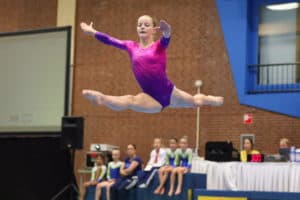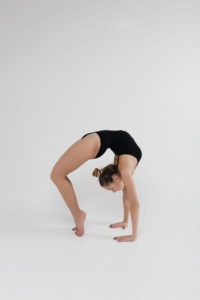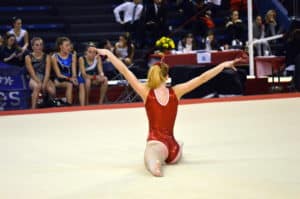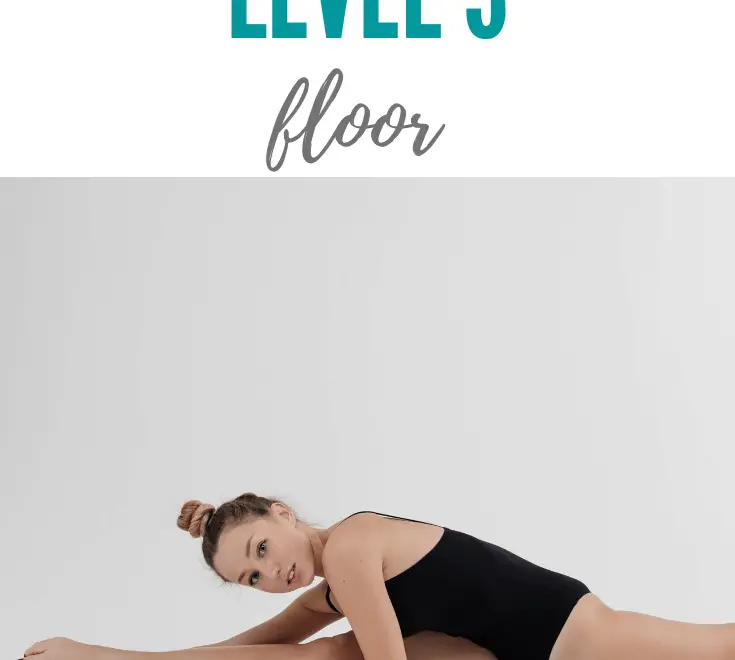This post has been updated to reflect the 2021-2029 compulsory routine changes, and was updated again in July 2023.
It’s time to polish up those compulsory routines! Today we will look at the Level 3 floor routine. This was always one of my favorite levels to coach, because the kids are just learning to compete, and it is so rewarding to teach them how to compete their first routines. And as a judge, well, you just never know what will happen! Sometimes these newbies will put together an amazing routine, and other times they might forget half of it because they are so overwhelmed. We definitely have to be ready for anything!
So you might be wondering, what are the judges looking for when we judge this Level 3 floor routine? Obviously, the gymnast needs to remember the routine. Besides that, there are a number of qualities that are important when determining the final score. Let’s take a look!
Overview of Level 3 Floor
The level 3 floor routine has a combination of acro and dance skills which progress toward higher level skills. Each skill is subject to both general execution deductions and specific element deductions for that skill. At the end of the routine, the judge will assess the routine based on general categories, such as rhythm and artistry. These “general deductions” are taken based on the routine as a whole. This means that in order to get a great Level 3 floor score, the gymnast will need to do well in each of the following areas:
- Good form and technique on all major elements
- Minimize specific element deductions
- Polish up the little details in the general routine categories
- No kicks into acro elements
- No straight leg entry into acro elements
- Two choices for acro entries: lunge entrance or mountain climber entrance
- Two choices for acro exits: lunge exit or step-in exit to straight stand
If you’ve coached prior to 2021, you’ll notice that these are different from past compulsory routines, but there are more options now to allow for flexibility in coaching techniques. Win-win for everyone!
General Execution Deductions
First, let’s look at general execution deductions. These deductions can be taken on any major element in the Level 3 floor routine. Here are some common deductions for this routine:
- Foot form – 0.05
- Leg separation – Up to 0.20
- Body alignment/position/posture in major elements – Up to 0.20
- Bent arms or legs (max deduction at 90 bend) – Up to 0.30
- Balance errors – Up to 0.30
- Fall (on or off the apparatus) – 0.50
- Failure to mark the passe position in releve at turn completion – 0.05
- Failure to contract or extend when indicated – Up to 0.10
- Leg swing/kick not to horizontal or above when required – Up to 0.10
- Uneven leg separation in leaps/jumps – Up to 0.20
- Failure to perform turns in high releve – Up to 0.10
- Failure to keep arms by ears in and out of slow acro elements – 0.05 each
- Not finishing with the music – 0.10
- Failure to land with feet together on 2-foot landing of jumps – Up to 0.10
- Insufficient split – Up to 0.20
- Stop between elements in an acro series on floor – 0.30
- Extra kick to handstand – 0.30
Specific Deductions for Level 3 Floor Skills
Here are each of the skills in the Level 3 floor routine, along with the specific deductions associated with each skill.
Side lunge, Pose, Side lunge, ¼ turn
Handstand forward roll
The gymnast will start by pointing her foot in front of her. Next, she should use one of the acceptable entry techniques (lunge or mountain climber entry). It is no longer required to lever into the handstand forward roll, but the gymnast must keep her arms by her ears as she moves into the skill.
The handstand forward roll must be performed with straight arms or a deduction of up to 0.30 can be taken. Just like in the handstand to bridge, the gymnast is expected to lever into the handstand. If she does not attain a vertical handstand, up to 0.30 can be deducted. The legs must close in vertical (0.10 deduction), and the handstand must be held for one second (up to 0.10 deduction). If the gymnast pushes off the floor with her hands to get up, she will incur a 0.30 deduction. The gymnast should finish in a straight stand.
Chasse, Pose, Pivot turn, Lunge pose
This series does not include any major elements, so the gymnast should focus on following the text, while keeping good posture and foot form. General deductions apply for errors in these categories.
Chasse, Straight leg leap, Fish pose

The chasse is not considered a major element in Level 3. This means that there are no specific element deductions for it, but general deductions still apply. The gymnast should focus on pointed toes and good posture during the chasse.
The leap is considered a major element, worth 0.60. The degree of split required for the leap is only 90°. The rationale for this is so that the gymnasts can focus on height (up to 0.20) and body position (up to 0.20). The deduction for uneven split (up to 0.20) can be applied if one leg is higher than the other. If the gymnast performs a stag leap (bending the front leg), she will incur a deduction of up to 0.10.
Straight jump, Split jump:
The emphasis during the straight jump is on leg and foot form, posture (up to 0.20), and hip rise (up to 0.20). The hips should rise during the jump, legs should stay straight with toes pointed, and the gymnast should land with good posture (chest up). The arms should be overhead during the jump, then lower before the split jump.
Just like the leap, only a 90° split is required during the split jump. Once again, the gymnast should focus on posture (up to 0.20) and hip rise (up to 0.20). Shoulders should be down, with arms in side-middle. The split should be even, without either leg rising higher than the other (up to 0.20).
Specific deductions can be taken for failure to land on both feet simultaneously in the split jump (flat 0.10), failure to keep legs joined in the air during straight jump (up to 0.10), and failure to land with feet closed (up to 0.10).
Handstand, bridge, kick-over:

The gymnast should keep her arms next to her ears during the entrance and exit (0.05 each). She can use either a lunge or mountain climber entry. If she requires an additional kick to reach the handstand position, a deduction of 0.30 would apply.
The legs should join in handstand before performing the bridge (0.10 deduction if they do not). When the gymnast lowers into the bridge, the shoulders should push backward over the hands (up to 0.2 deduction). The feet should land at the same time (flat 0.10 deduction), but there is no deduction if the feet land apart or if the knees bend on landing. Then the gymnast should perform the back kickover with at least a 120 separation (up to 0.20 deduction). The kickover can finish either in a lunge or a step-in to straight stand.
If the legs remain separated throughout the entire skill, a 0.30 deduction would be applied for performing a tic-toc.
General execution deductions also apply, such as bent arms, bent legs, and poor foot form. Extra kicks that occur in order to perform the kickover will each receive a 0.30 deduction. If the gymnast falls onto her back after a failed kickover, the 0.50 deduction for a fall would be applied.
Forward split

The gymnast should perform a full split with good posture. If she does not achieve a 180 degree split position, an up to 0.20 deduction can be applied. General deductions for posture and foot form will also apply.
Prone spin, Log roll, Turn to stand
General deductions apply. The gymnast should perform the choreography with good artistry and rhythm, and the movements should match the music.
½ turn in forward passe
The gymnast first performs a lock pose, then points the foot forward. She should transfer the weight onto the front foot to perform the ½ turn. If she uses a heel-snap turn technique, the deduction is 0.30. The free leg should be in forward passe (0.10 deduction). Deductions can also be applied for failure to perform the turn in high releve (up to 0.10) and incomplete turn (up to the value of the element – up to 0.40), as well as posture (up to 0.20) and foot form (0.05). Balance errors apply if the gymnast is not in control at the end of the turn.
Backward roll to 45°, pushup position
A tucked or piked entry is acceptable into the backward roll. The gymnast should perform the roll without placing the hands on the floor prior to rolling backward (0.30 deduction). She should maintain straight arms (up to 0.30), and the hands should be placed no further than shoulder-width apart ( 0.10). If the fingers are interlocked, it is a 0.10 deduction. She should finish in a hollow body pushup position (0.20 for failure to show pushup position, up to 0.20 for body position errors).
The angle of completion should be 45° above horizontal. If that angle is less than 45° above horizontal, an up to 0.20 deduction applies. The roll is not allowed to go to handstand, or a 0.40 deduction will apply.
The angle of the roll is evaluated from the shoulders to the lowest body part. Similar to the evaluation of a cast on bars, the lowest body part can vary based on the gymnast’s body position. If she is arched, her stomach will be her lowest body part, and the angle is measured from the shoulders to the stomach. If she is piked, the lowest body part is the feet. If her body is straight, the line is drawn straight down the length of the body from the shoulders to the feet. Body position errors are deducted in addition to amplitude errors.
Next she will perform a kneeling pose, then a series of poses upon her return to stand.
Roundoff, back handspring rebound
The gymnast can run any number of steps into the pass with no deduction. She must pass through vertical in the roundoff (up to 0.30 deduction), and land on both feet at the same time (0.10 deduction for each element).
If she squats into the back handspring, she can incur a deduction of up to 0.20. The rebound must be immediate after the back handspring (0.10 deduction), and she must pause in a controlled “stick” position (0.05 deduction).
All tumbling passes must show an immediate connection between elements. If there is a stop between elements in an acro series/tumbling pass, a 0.30 deduction is applied each time. If the elements are slow, but connected, an up to 0.20 lack of acceleration deduction can apply.
General deductions also apply to the roundoff and back handspring. They should be performed with straight arms and legs, and good body position (tight arch/hollow, no pike down). The feet should be pointed and together on the back handspring. The gymnast should land in control, or balance deductions can be applied.
Ending Poses
The routine ends with three poses. The first two poses are specific to the text, and the final pose is optional with guidelines. During the final pose, the knees must be together, buttocks on the heels, and torso straight up and down. The arms and focus are optional.
General deductions apply to all of the poses. The gymnast should maintain good posture and finish with the music (flat 0.10 deduction if she does not).
General Deductions in a Level 3 Floor Routine
General deductions have been mentioned many times in this article – now what does that mean?
During the choreography components of the Level 3 floor routine, also called non-value parts (or non-VP’s), general deductions are used. Judges make notes of small errors during the routine in each of the general categories, and determine a total deduction after looking at the routine as a whole.
General deductions on floor consist of the following:
- Text errors – up to 0.30
In the compulsory handbook, this is described as “incorrect position of head, arms, legs, or feet”. - Artistry – up to 0.30
This deduction is broken down into two parts: up to 0.15 for quality of the gymnast’s movement to reflect the choreography, and up to 0.15 for quality of expression, including projection, emotion, and focus. - Rhythm – up to 0.20
Rhythm deductions are taken for not performing the routine in time with the music, or performing a section with incorrect rhythm compared to what is listed in the text.. An additional 0.10 can be taken if the gymnast does not end the routine in time with the music. - Posture: up to 0.30
This can be applied for any postural errors during choreography, such as ribs out, bottom out, head forward, shoulders slumped, etc. - Footwork – up to 0.30
Feet should be pointed anytime they leave the ground, and the gymnast should stand and step in releve when indicated. She should also show turn-out in her foot positions. - High releve: up to 0.20
Gymnast should perform steps and pivot turns in high releve throughout the routine, when indicated.
For more information on general deductions, see General Categories for Exemplary Compulsories.
Summary of the Level 3 Floor Routine
References
USA Gymnastics Compulsory Handbook, 2021-29.
Further Reading
Preview of 2021-2029 Compulsory Skills
